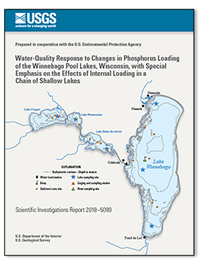Water-quality response to changes in phosphorus loading of the Winnebago Pool Lakes, Wisconsin, with special emphasis on the effects of internal loading in a chain of shallow lakes
Links
- Document: Report (3.70 MB pdf)
- Data Release: USGS data release - Eutrophication water-quality models and supporting water-quality and phosphorus load data used to simulate changes in the water quality of the Winnebago Pool Lakes, Wisconsin, in response to change in phosphorus loading
- Download citation as: RIS | Dublin Core
Abstract
The Winnebago Pool is a chain of four shallow lakes (Lake Poygan, Lake Winneconne, Lake Butte des Morts, and Lake Winnebago) that are fed primarily by the Fox and Wolf Rivers, two large agriculturally dominated rivers in Wisconsin, United States. Because the lakes have received extensive phosphorus inputs from their watershed, they have become highly eutrophic with much phosphorus in the water column as well as trapped in their sediments. Each of the four Winnebago Pool lakes has been included on the Wisconsin Department of Natural Resources impaired waters list because of their high total phosphorus concentrations, water-quality use restrictions, and excess algal growth. The study described in this report is part of a Total Maximum Daily Load investigation to determine what actions are needed to improve the water quality (trophic status) of these lakes and thus be able to be removed from the impaired waters list and restore their designated uses. As part of this study, data were collected to describe the existing water quality of the lakes, detailed phosphorus budgets were developed for each of the lakes to describe the different sources of the phosphorus, and two eutrophication models (BATHTUB and Jensen models) were used to determine how much of the phosphorus being input to the lakes needs to be reduced for the lakes to be removed from the impaired waters list and restore their designated uses.
In-lake water-quality data indicated that each of the lakes had extensive vertical mixing that resulted in their water quality deteriorating throughout summer. Each of the lakes had mean summer total phosphorus concentrations exceeding 0.088 milligram per liter (mg/L), well above the 0.040 mg/L criterion for the lakes. Detailed phosphorus budgets for the lakes indicated that the primary sources of phosphorus were from their tributaries (for the most upstream lake in the Winnebago Pool–Lake Poygan) or from a combination of input from the upstream lakes and phosphorus release from the bottom sediment when only the summer months were considered (for the other three lakes).
Model simulations with the BATHTUB and Jensen models indicated that (1) the lakes should have almost linear response in their total phosphorus concentrations to changes in their phosphorus inputs; (2) phosphorus inputs need to be reduced by about 60 percent to the Upper Pool Lakes and 69–73 percent to Lake Winnebago to reduce their mean summer total phosphorus concentrations to 0.040 mg/L; and (3) if all the anthropogenic phosphorus inputs to the lakes could be eliminated, their best possible mean summer total phosphorus concentrations should decrease to about 0.022–0.028 mg/L in the Upper Pool Lakes and to 0.032–0.033 mg/L in Lake Winnebago. The effects of any reduction in phosphorus loading will take many years (50 to more than 75 years) to be fully realized in lake water quality because of phosphorus release from the lake sediments. The effects of nutrient reductions in the watershed of a chain of lakes, such as the Winnebago Pool, gradually cascades down the chain, which has beneficial and detrimental effects. Any action made in the watershed of upstream lakes to reduce phosphorus inputs should improve the water quality of all downstream lakes; however, the upstream lakes delay the response in the downstream lakes, especially in lakes where internal phosphorus loading is important.
Suggested Citation
Robertson, D.M., Siebers, B.J., Diebel, M.W., and Somor, A.J., 2018, Water-quality response to changes in phosphorus loading of the Winnebago Pool Lakes, Wisconsin, with special emphasis on the effects of internal loading in a chain of shallow lakes: U.S. Geological Survey Scientific Investigations Report 2018–5099, 58 p., https://doi.org/10.3133/sir20185099.
ISSN: 2328-0328 (online)
Study Area
Table of Contents
- Acknowledgments
- Abstract
- Introduction
- Methods
- Lake Water Quality
- Hydrology and Water Budget
- Phosphorus Inputs to the Winnebago Pool Lakes
- Simulated Changes in Water Quality in Response to Changes in Phosphorus Loading
- Importance of Internal Phosphorus Loading
- Effects of Changes in Phosphorus Loading Cascading Down a Chain of Lakes
- Summary and Conclusions
- References Cited
| Publication type | Report |
|---|---|
| Publication Subtype | USGS Numbered Series |
| Title | Water-quality response to changes in phosphorus loading of the Winnebago Pool Lakes, Wisconsin, with special emphasis on the effects of internal loading in a chain of shallow lakes |
| Series title | Scientific Investigations Report |
| Series number | 2018-5099 |
| DOI | 10.3133/sir20185099 |
| Publication Date | August 22, 2018 |
| Year Published | 2018 |
| Language | English |
| Publisher | U.S. Geological Survey |
| Publisher location | Reston, VA |
| Contributing office(s) | Wisconsin Water Science Center |
| Description | Report: ix, 58 p.; Data Release |
| Country | United States |
| State | Wisconsin |
| Other Geospatial | Winnebago Pool Lakes |
| Online Only (Y/N) | Y |
| Additional Online Files (Y/N) | N |


